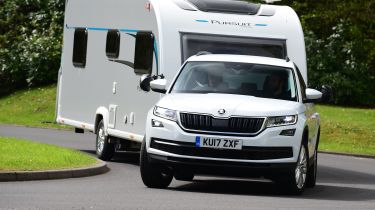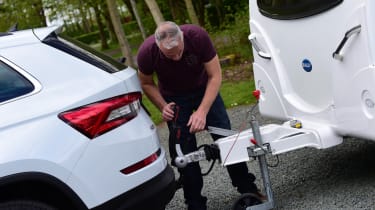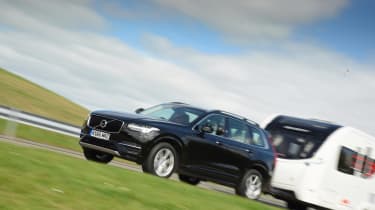Whether you’re towing a caravan, a trailer or even a boat, our towing guide explains how to do it
- Towing guide 2022: UK laws, licences, costs and tips
- Towing courses: we take a caravan towing lesson
Whether you are planning to tow a caravan, a trailer, a horsebox, or a boat, it is important to understand what your driving licence entitles you to tow, the laws governing towing in the UK, and how to tow safely. Our complete guide to towing in the UK covers it all.
How to determine your car’s towing capacity
Not all vehicles are suitable for towing but those that are have a set weight limit that they can tow both legally and safely. It is crucial that you check these limits before hooking up a trailer in order to prevent potentially severe damage to the vehicle or even an accident out on the road.
Caravaning for beginners: how to choose a caravan and tow it with confidence
Your car’s handbook should tell you if it is capable of towing and the maximum weight that it can safely handle. Alternatively this information is sometimes located on the Vehicle Identification Number (VIN) plate. If this information cannot be found, it is very likely that your car is not suitable for towing.
Two maximum towing weights may be shown, one for a braked trailer and the other for an unbraked trailer.
If your trailer weighs over 750kg when loaded, it must be fitted with a braking system that is in good working order. While some smaller trailers under 750kg may also have brakes fitted, these are not a legal requirement.
If you need to manually calculate your car’s maximum towing capacity, then also displayed on the VIN plate or in the handbook will be your vehicle’s weight. As with towing weights, more than one amount will probably be displayed. You can expect to see the vehicle’s Maximum Allowable Mass, the gross train weight (the most the car and trailer can weigh when combined), and the maximum axle loads for the vehicle.
The simplest formula to follow when working out your car’s maximum towing capacity is to subtract the car’s MAM from the gross train weight. Your car’s towing capacity will be total remaining once the car’s weight has been removed from the gross train weight, the maximum weight of the trailer itself.
Once you know this figure, it is very important to then add in the weight of any extra payload that you will be placing inside the trailer – such as luggage in a caravan or a horse in a horsebox. If you need some help in working out your total figure, you could purchase a towing scale.
Whatever you are towing must never exceed the trailer’s MAM or the car’s maximum towing capacity. These must be treated as absolute limits and the sensible option is to keep well below them to be safe.
Towing licence rules: what can you legally tow in the UK?
In December 2021, the law was changed to allow more drivers to legally tow trailers without any added endorsements on their licence or towing tests. Following that change, these are the current UK towing rules…
- If you passed your driving test before 1 January 1997
You are allowed, in most cases, to to drive a vehicle and trailer combination up to 8,250kg MAM. You’re also allowed to drive a minibus with a trailer over 750kg MAM. - If you passed your driving test after 1 January 1997
You are allowed, in most cases, to to drive a vehicle and trailer combination up to 3,500kg MAM
Prior to the 2021 rule change, drivers who passed their test after 1997 would have had to undergo additional training and pass a dedicated car and trailer test if they wished to tow anything heavier than 750kg. However, this test is no longer required.
As a result of the rule change, whenever drivers who passed their test after 1997 receive a new driving licence – such as when you renew or change your details – category BE will be added to it. In the meantime, your current licence will still qualify you for this category, even if it isn’t physically marked.
Towing a heavier vehicle and trailer combination: what do you need?
If you need to tow a load that’s heavier than what your standard licence allows, you will need to hold a category C1E licence – this allows you to drive medium-sized vehicles between 3,500 and 7,500kg MAM (with a trailer up to 750kg). The combined MAM of both must not exceed 12,000kg.
Towing safely and legally
When towing on public roads, if you are deemed to be doing so in an unsafe manner you could be prosecuted and liable for a large fine, penalty points or even a driving ban. Therefore, it is important to take every step you can to ensure that you are as safe as possible. Be sure to remember the following:
- If you are purchasing a tow bar for your car, it must be type-approved – this means that it has been approved for use in the UK and EU and is suitable for your vehicle. This does not apply, however, if the vehicle was first used before 1 August 1998.
- It is also important to fit extended towing mirrors if your rear visibility is obstructed – such as when towing a horsebox or a caravan. If you fail to do so you could be fined up to £1,000 and receive 3 penalty points on your licence.
- A number plate also needs to be fitted to the trailer, and this must match the towing vehicle’s registration number at all times.
- If you are loading the trailer, caravan, horsebox etc. ensure that this weight is evenly spread out as this will help to avoid unstable handling and any excessive wear on the wheels and tyres.
- The maximum length for a trailer towed by a vehicle weighing up to 3,500kg is 7 metres.
- The maximum width for a trailer towed by any vehicle is 2.55 metres.
Towing Speed limits
Different speed limits may apply when you are towing, these are the current restrictions.
UK speed limits: everything you need to know
As normal, the usual speed limit of 30 miles per hour applies to all single and dual carriageways with street lights, unless there are signs showing otherwise. However, in other situations, the following limits apply:
Built-up areas mph | Single carriageways mph | Dual carriageways mph | Motorways mph | |
Cars, motorcycles, car-derived vans and dual-purpose vehicles when towing caravans or trailers | 30 | 50 | 60 | 60 |
Motorhomes or motor caravans (not more than 3.05 tonnes maximum unladen weight) | 30 | 60 | 70 | 70 |
Motorhomes or motor caravans (more than 3.05 tonnes maximum unladen weight) | 30 | 50 | 60 | 70 |
Buses, coaches and minibuses (not more than 12 metres overall length) | 30 | 50 | 60 | 70 |
Buses, coaches and minibuses (more than 12 metres overall length) | 30 | 50 | 60 | 60 |
Goods vehicles (not more than 7.5 tonnes maximum laden weight) | 30 | 50 | 60 | 70 60 if articulated or towing a trailer |
Goods vehicles (more than 7.5 tonnes maximum laden weight) in England and Wales | 30 | 50 | 60 | 60 |
Goods vehicles (more than 7.5 tonnes maximum laden weight) in Scotland | 30 | 40 | 50 | 60 |
Towing a caravan
There are a few extra things to take into account when towing your home from home.
Just as you would with a standard trailer, you must be sure of the caravan’s weight, which can add up to a significant amount when it’s fully loaded. To make things a bit easier, this should be displayed on a plate or in the caravan’s handbook.
When measuring the total weight of the caravan, you will need to include the towing car’s occupants and any luggage in the car or caravan. If you think that you are particularly close to your car’s maximum towing capacity, it could be a wise move to get a more accurate figure using a dedicated measurement tool.
In some cases, a caravan’s Maximum Authorised Mass (MAM) might instead be referred to as its Maximum Technically Permissible Laden Mass (MTPLM). This is the maximum permitted weight when all furnishings and luggage are on board.
Towing training courses
While the car and trailer driving test test is no longer a legal requirement, the DVSA is urging drivers to still seek training before towing for safety reasons. It certainly isn’t a bad idea to get some lessons to not only boost your towing safety, but also your confidence. Fortunately, there are a number of private driving schools and other organisations that still offer towing courses.
If you are unsure of any rules that apply to towing on UK roads, you can find further information at Gov.uk.
Common towing terms explained
- Towing capacity: the maximum amount of weight your car can safely and legally tow.
- Maximum Authorised Mass (MAM): the weight of a vehicle or trailer including the maximum load that can be carried safely when on the road. This can also sometimes be referred to as gross vehicle weight (GVW) or permissible maximum weight.
- Maximum Technically Permissible Laden Mass (MTPLM): an alternative term for the MAM of a caravan with all luggage and furnishings on board.
- Mass in Running Order (MIRO): – the caravan’s weight in the manufacturer’s standard spec.
- Unladen weight: the weight of a vehicle that isn’t carrying any passengers or luggage. Other variables such as fuel are also not taken into account.
- Unbraked trailer: A trailer without its own braking system.
- Braked trailer: A trailer with its own braking system.
- Noseweight: The weight of your caravan and its contents on the tow ball
- Snaking: An unstable side-to-side movement made by the caravan, sometimes caused by wind
Caravans and motorhomes on Auto Express…
Caravans
- Caravaning for beginners: choose a caravan and tow it with confidence
- Kitting out your caravan: best camping accessories for 2022
- Top 20 best touring caravan sites in the UK
Motorhomes
- Best motorhomes 2022: the top 5 picks for all budgets
- Buying a motorhome in the UK: complete guide and top tips
Towing
- Towing guide
- Best tow cars to buy in 2022
Continue Reading
- 1Towing guide 2022: UK laws, licences, costs and tips – currently readingWhether you’re towing a caravan, a trailer or even a boat, our towing guide explains how to do it
- 2Towing courses: we take a caravan towing lessonWe hook up with professional instructor Matt Price for some valuable tips on towing
Source: Read Full Article


 Caravaning for beginners: how to choose a caravan and tow it with confidence
Caravaning for beginners: how to choose a caravan and tow it with confidence
 UK speed limits: everything you need to know
UK speed limits: everything you need to know
